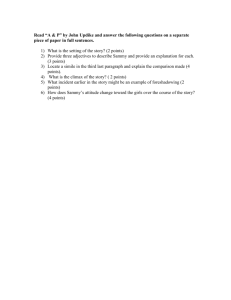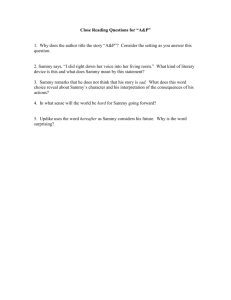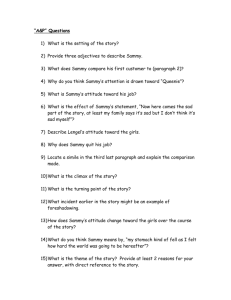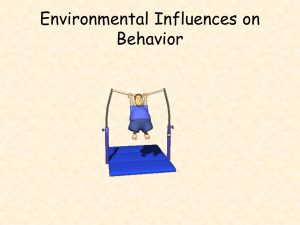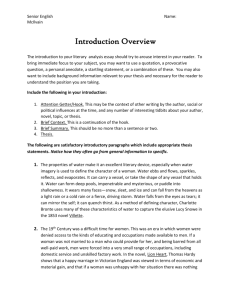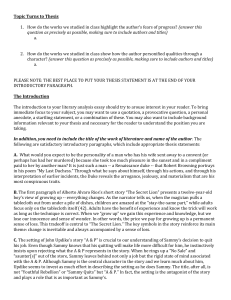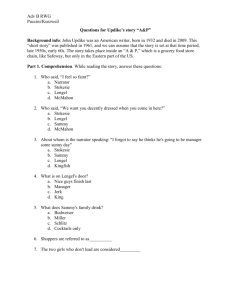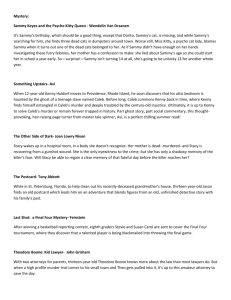Essay 1 Mutants
advertisement
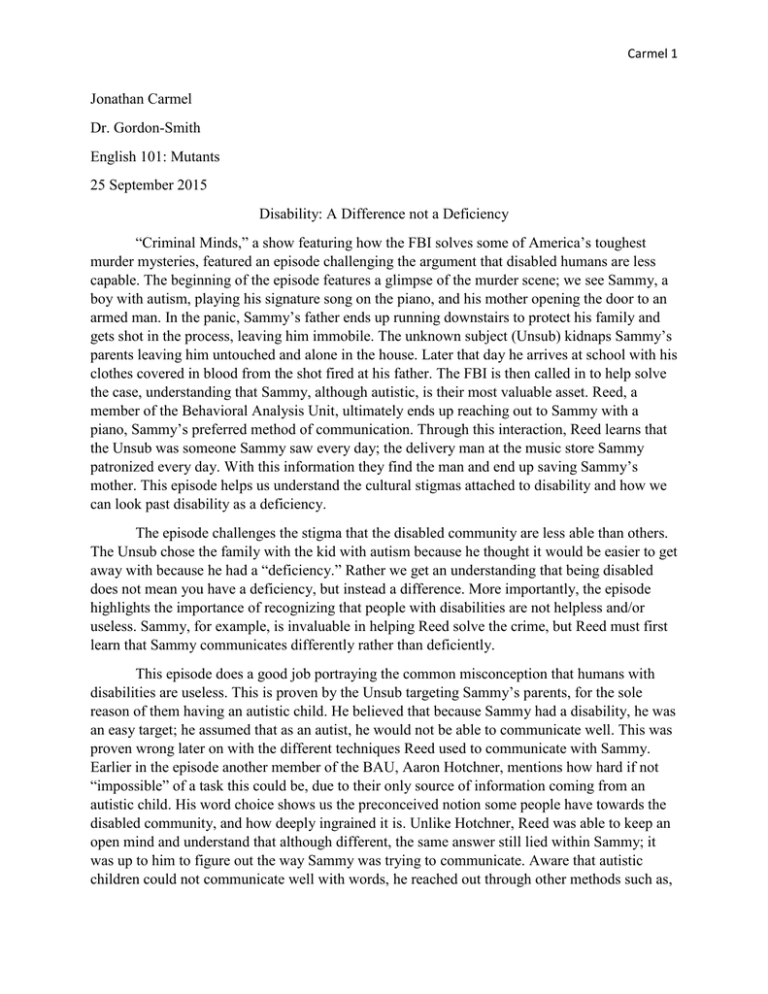
Carmel 1 Jonathan Carmel Dr. Gordon-Smith English 101: Mutants 25 September 2015 Disability: A Difference not a Deficiency “Criminal Minds,” a show featuring how the FBI solves some of America’s toughest murder mysteries, featured an episode challenging the argument that disabled humans are less capable. The beginning of the episode features a glimpse of the murder scene; we see Sammy, a boy with autism, playing his signature song on the piano, and his mother opening the door to an armed man. In the panic, Sammy’s father ends up running downstairs to protect his family and gets shot in the process, leaving him immobile. The unknown subject (Unsub) kidnaps Sammy’s parents leaving him untouched and alone in the house. Later that day he arrives at school with his clothes covered in blood from the shot fired at his father. The FBI is then called in to help solve the case, understanding that Sammy, although autistic, is their most valuable asset. Reed, a member of the Behavioral Analysis Unit, ultimately ends up reaching out to Sammy with a piano, Sammy’s preferred method of communication. Through this interaction, Reed learns that the Unsub was someone Sammy saw every day; the delivery man at the music store Sammy patronized every day. With this information they find the man and end up saving Sammy’s mother. This episode helps us understand the cultural stigmas attached to disability and how we can look past disability as a deficiency. The episode challenges the stigma that the disabled community are less able than others. The Unsub chose the family with the kid with autism because he thought it would be easier to get away with because he had a “deficiency.” Rather we get an understanding that being disabled does not mean you have a deficiency, but instead a difference. More importantly, the episode highlights the importance of recognizing that people with disabilities are not helpless and/or useless. Sammy, for example, is invaluable in helping Reed solve the crime, but Reed must first learn that Sammy communicates differently rather than deficiently. This episode does a good job portraying the common misconception that humans with disabilities are useless. This is proven by the Unsub targeting Sammy’s parents, for the sole reason of them having an autistic child. He believed that because Sammy had a disability, he was an easy target; he assumed that as an autist, he would not be able to communicate well. This was proven wrong later on with the different techniques Reed used to communicate with Sammy. Earlier in the episode another member of the BAU, Aaron Hotchner, mentions how hard if not “impossible” of a task this could be, due to their only source of information coming from an autistic child. His word choice shows us the preconceived notion some people have towards the disabled community, and how deeply ingrained it is. Unlike Hotchner, Reed was able to keep an open mind and understand that although different, the same answer still lied within Sammy; it was up to him to figure out the way Sammy was trying to communicate. Aware that autistic children could not communicate well with words, he reached out through other methods such as, Carmel 2 drawings and the piano. The drawings that Sammy made were of a right angle pointing to three o’ clock. In addition, Sammy would play his favorite piano song when Reed took him back to the house of the crime scene. By putting two and two together, Reed understood that Sammy was trying to tell him that the Unsub visited the music store with him at three o’ clock. This example is important as it portrays the disabled community as something other than useless; Sammy was trying to communicate with the BAU all along, just in a different way. This brings back the notion that disability is not a deficiency, but rather a difference. We get a better understanding of society’s bias towards the disabled community with Hotchner and the Unsub; while Reed shows us how we should be thinking with an open mind. Through this we understand society’s unwillingness to change even when proven wrong countless times. If the “disabled” community can solve the same problems anyone else could, the idea of them being unable is ludicrous. In the bigger picture the show is trying to reinforce the idea that being disabled does not make someone useless. While growing up most people are told that there are certain ways to solve a problem and to stick to them. We need to remove the negative connotation that the word “disabled” carries and instead understand that different is fine. When thinking about that community, we should think of them as “differently abled”, rather than “disabled.” Although these two words might be talking about the same group of people, they both have different connotations. The word “disabled,” has an innate negative connotation as it literally means to have limitations. Whereas, the term “differently abled” expresses the ideas of being able to do something but in a different way. In this case we have an autistic ten year old boy who just solved a case of murder. Even though Sammy was not able to communicate through words, the message was still passed on through other methods; therefore, achieving the same result. If Sammy was able to communicate with the BAU effectively enough to tell them who kidnapped his parents, then think of the potential talent going to waste. This episode of “Criminal Minds” did a perfect job on illustrating the change that must happen in the way we treat the disabled community. If we can get the media to portray the disabled community with a positive connotation, then a spark for change will occur. The producers of “Criminal Minds” effectively challenged the idea of a disability being an impossible obstacle to move around by using Sammy. Reed played a vital role in this episode, understanding that people have different ways of communicating and that the possibility for success is high given the right approach. Sammy was able to prove that a disability does not equal a deficiency, but rather a difference. The message that we should take away from this episode is that the disabled community are not less able than anyone else. More specifically, that the same solution could be reached by both parties, only thing differing is the method used. This episode should reinforce the idea in the observers mind that a disability does not equal a deficiency, rather a difference in method. Society must stop looking at the “disabled” community as having limitations, but instead understand that they are just “differently abled.” The day society accepts that being different is ok, is the day we lose our disability.
